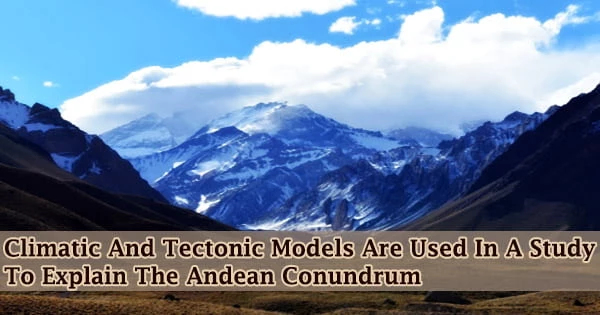For decades, geologists have been confused by the fact that the Andes Mountains are significantly taller than plate tectonic models predict. When tectonic plates meet and push rocks skyward, mountain-building models tend to focus on the deep-seated compressional forces that occur.
A new study shows how combining current top-down models that account for climate-related elements with traditional bottom-up tectonic models can help unravel the Andes Mountains’ puzzling history.
The research was published in the journal Nature Communications by former University of Illinois Urbana-Champaign graduate student Jiashun Hu, Illinois geology professor Lijun Liu, and California Institute of Technology professor Michael Gurnis.
“The Andes are unique for their tectonic setting,” Liu said. “The central portion of the range is abnormally tall for one formed by the relatively low compressional stress and weak plate interface coupling we think occurs when thin, dense oceanic crust subducts or slides under thick continental crust.”
According to geochemical and chronological evidence, the most recent Andean Mountain-building episode began 40 million years ago, and the most substantial crustal shortening began in the central-to-northern region of the present-day Andes and subsequently moved toward the south.
According to Liu, there is geologic evidence along the Andean coast suggesting the southward expansion of Andean Mountain development continues now, but it is still unclear what is triggering this migration and considerable crustal deformation.
Numerous studies suggest that higher erosion rates in the southern Andes, which are caused by a warmer and wetter environment than in the north, coincide chronologically with evidence of increased sediment influx into the Andean Trench.
The Andes are unique for their tectonic setting. The central portion of the range is abnormally tall for one formed by the relatively low compressional stress and weak plate interface coupling we think occurs when thin, dense oceanic crust subducts or slides under thick continental crust.
Lijun Liu
The sediment, which deposited along the bottom of the trench along the Nazca plate’s subducting edge, may have functioned as a lubricant atop the subducting plate, lowering compressional forces and resulting in lower mountains, according to the researchers.
The effect of the Juan Fernandez Ridge, a submerged volcanic hotspot chain that still exists today, has been discovered by Liu’s team, who have taken this climatic-tectonic relationship a step further by revealing the effect of a strange east-west trending structure known as the Juan Fernandez Ridge.
“Today, where the Juan Fernandez Ridge intersects the coast of Chile, it acts as a barrier to the northward-migrating sediments,” said Hu, the lead author of the study. “We hypothesize that this ridge has existed for millions of years, slowly migrating southward with the subducting Nazca Plate, starving the northern Andean Trench of sediments that helped increase the plate coupling and mountain building behind the migrating ridge.”
The team’s new model takes into account the Juan Fernandez Ridge’s impact on sediment transport over time.
“When we use our model to reverse time and reconstruct the subduction history of the Nazca Plate in 3D space, the effects of including the Juan Fernandez Ridge correspond remarkably well with geologic features we see in the Andes today,” Hu said.
According to the paper, the model has yet to be verified against the wide range of hypotheses for the creation of the Andes Mountains, some of which contain highly intricate plate subduction geometries.
“This study is a critical step forward to have the ability to quantitatively link climate and tectonics something not well represented in the past studies,” Liu said.
This research was funded by the National Science Foundation, the Chinese National Natural Science Foundation, and the Southern University of Science and Technology’s Center for Computational Science and Engineering.





